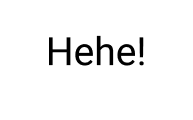Association
Shapes
Have you ever wondered why we (can) see shapes in the clouds? Up front. It is not because the clouds actually resemble a shape (animal, face, ...) that much. It is because our mind is actively looking for shapes known to it to be able to make quick decisions. Some say that is, because in the evolution of human beings it was of advantage when we had to run away from preditor animals. Imagine your self strolling through the jungle, looking for a good ol’ banana tree.







It is better to have several false alarms than to be eaten once too often ;) That is made possible by the associative nature of our brain. We connect things together, store them and retain them in similar situations. Associations have a lot to do with categories.
Categories
We group together information and that way try to make sense out of it. This is a simplified example of semantic categorization.
What if our mind is unsure about how to categorize information? Well, usually we will subconciously push the information into any category that seems fit (#darkpattern). Remember, our mind doesn’t like ambiguity. Btw, next to generalization, this is one of the main roots of arguments and prejudgement. We ‘need’ the information to fall into a category. Also, this is a source for errors and mistakes. For example, did you know?
A penguine is not a bird!
That is not true. A penguine is a bird. And now I feel bad for saying that. I mean, just look at it. But the point is that it probably took you a little longer than it would to figure out whether a sparrow is a bird. Elements within a category have a ‘typicality gradient’. The gradient will determine the probability of mental activation. The more properties an element shares with the category, the higher its typicality gradient is. Penguines have a beak and wings with feathers but they can’t fly. When I say the word “bird”, you will more likely think of a sparrow than a penguine. Well, unless you are a penguine specialist, which leads us to the next mechanism. Penguine specialization .... Sorry I meant, Priming. (Can you figure out why this mistake happened?)
Priming
Do you know that your browser is caching information to improve on speed with faster loading times? Well, the same does your brain, with a different physiological approach, though. It is called priming. The more often and recent a chunk of information is used, the higher the probability of activation. An online video platform is using this as a dark pattern. What it basically does is to force some CTAs on you. They are structured as below.
Blue is your actually desired option. You will be shown this CTA a couple of times. This way a person is wired to associate the ‘blue’ CTA with his preferred option. After some exposure, the colour logic changes.
The probability of clicking the undesired answer rises significantly, since the user is primed on the colour and location of the blue link.
Priming also works with associations that are not directly mentioned. When we say “bird”, our brain not only activates all information for the bird category but also some information in categories linked/associated to that category. For example:
That effect is called ‘spreading activation’ and is not necessarily a concious process. In the illustration above, the association ‘flight’ is more likely than ‘airplane’, made visible by the colour intensity of the knots. The reason is that, depending on our past experiences, some associations are more likely to be activated.
But also the situation our user is or recently has been in has influence on the activation probability, regardless of whether the user is in a digital or non-digital environment. The more triggers there are in the current environment, the greater the probability of associative activation. That doesn’t mean to clutter the screen with triggers. They still need to be distinguishable from the background and carry importance.
That is why UX Design has to take the user’s situation, past experiences and mental model into account. It also suggests the importance of analytic services. Controlling the digital environment has an impact on the categories we want our users to have activated.
Excursion: You can use associations and 'spreading activation' yourself. Have you ever been desperately thinking about where you have put your keys? Just go from room to room. Triggers in the room in which you have actually put your keys will significantly increase the likelihood of remembering. Try it, it works.
In the next chapter we will talk about the concepts of communication. Simply follow this link.